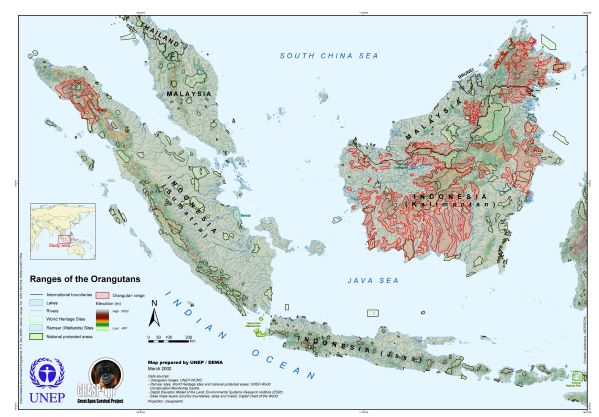Fossil evidence suggests the orangutan once ranged throughout most of the southeast and mainland Asia, encompassing both high and lowland areas in the wet and seasonal tropics of modern-day Vietnam, northern India, and southern China (van Schaik & Delgado, 2000). Today, the orangutan is the only great ape found in Asia. It lives on just two islands: Borneo and Sumatra. Located in the Malay/Indonesian archipelago and part of the large Sunda continental shelf, Borneo and Sumatra are two of the world’s largest islands. They are isolated from each other by the South China Sea.

For many years, the orangutan was classified as one species with two subspecies that differ in appearance and behavior: the Bornean orangutan (Pongo pygmaeus pygameus) and the Sumatran orangutan (Pongo pygmaeus abelii). However, DNA analysis suggested that the genetic difference between them is no greater than the differences that comfortably separate species in other animals like chimpanzees and gorillas. As a result, scientists (Warren, et. al, 2001) claimed that they were two distinct species (Pongo abelii and Pongo pygmaeus). However, recently a small population of Sumatran orangutans from the Batang Toru area south of Lake Toba was reclassified as a new species named Pongo tapanuliesis in 2017, based on both morphological and genetic differences (Nater, et al., 2017).
There are a number of sub-species of the Bornean orangutan. Molecular data suggests the Bornean and Sumatran orangutans diverged between 2.7 and 5 million years ago, and that the Bornean orangutan underwent a population expansion between 39,000-64,000 years ago, with the island’s rivers strongly determining migration routes and contributing to the genetic differences in Bornean populations (Goossens et al, 2009).
There are currently two accepted sub-species:
A third population of orangutans living south of the Mahakam River in East Kalimantan and in the Malaysian state of Sabah is either a third, separate sub-species (pongo pygmaeus morio), or a separate population of the Western Bornean orangutan (Goossens et al, 2009).
Goossens, B., Chikhi L., Jalil, M.F., James S., Ancrenaz, M., Lackman-Ancrenaz, I. & Bruford, M.W. (2009). Taxonomy, geographic variation and population genetics of Bornean and Sumatran orangutans. In Wich, S.A., Atmoko, S.S.U., Setia T.M. & Van Schaik, C.P., editors, Orangutans: Geographic variation in Behavioral Ecology and Conservation, Oxford University Press, UK.
Nater, A. et al. (2017) Curr. Biol. http://dx.doi.org/10.1016/j.cub.2017.09.047.
Van Schaik, C.P. & Delgado, R. (2000). The behavioral ecology and conservation of the orangutan: A tale of two islands. Evolutionary Anthropology, 9, pp. 201-18.
Warren, C., Verschoor, E., Langenhuijzen, S., Heriyanto, Swan, R. Vigilant, L., Heeney, J. (2001). Speciation and Intrasubspecific Variation of Bornean Orangutans, Pongo pygmaeus pygmaeus. Molecular Biology and Evolution, 18 (4), pp 472–480, https://doi.org/10.1093/oxfordjournals.molbev.a003826